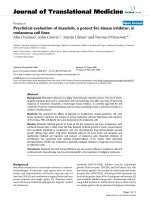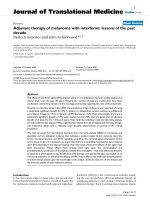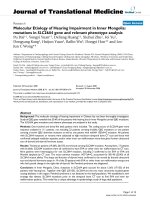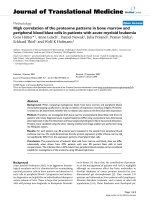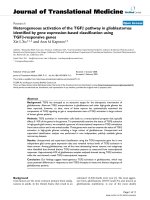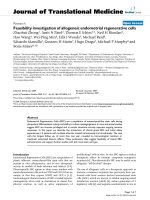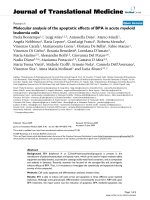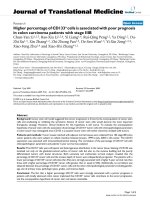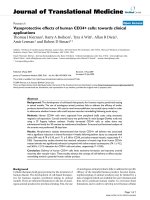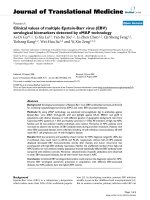báo cáo hóa học:" Quick assessment of hopelessness: a cross-sectional study" pot
Bạn đang xem bản rút gọn của tài liệu. Xem và tải ngay bản đầy đủ của tài liệu tại đây (254.39 KB, 6 trang )
BioMed Central
Page 1 of 6
(page number not for citation purposes)
Health and Quality of Life Outcomes
Open Access
Research
Quick assessment of hopelessness: a cross-sectional study
Paul SF Yip
1
and Yin Bun Cheung*
2
Address:
1
The Hong Kong Jockey Club Centre for Suicide Research and Prevention, The University of Hong Kong, Pokfulam Road, Hong Kong SAR
and
2
MRC Tropical Epidemiology Group, London School of Hygiene & Tropical Medicine, UK
Email: Paul SF Yip - ; Yin Bun Cheung* -
* Corresponding author
Abstract
Background: Lengthy questionnaires reduce data quality and impose a burden on respondents.
Previous researchers proposed that a single item ("My future seems dark to me") and a 4-item
component of the Beck's Hopelessness Scale (BHS) can summarise most of the information the
BHS provides. There is no clear indication of what BHS cutoff values are useful in identifying people
with suicide tendency.
Methods: In a population-based study of Chinese people aged between 15 and 59 in Hong Kong,
the Chinese version of the BHS and the Centre for Epidemiologic Studies – Depression scale were
administered by trained interviewers and suicidal ideation and suicidal attempts were self-reported.
Receiver operating characteristics curve analysis and regression analysis were used to compare the
performance of the BHS and its components in identifying people with suicidality and depression.
Smoothed level of suicidal tendency was assessed in relation to scores on the BHS and its
component to identify thresholds.
Results: It is found that the 4-item component and, to a lesser extent, the single item of the BHS
perform in ways similar to the BHS. There are non-linear relationship between suicidality and
scores on the BHS and the 4-item component; cutoff values identified accordingly have sensitivity
and specificity of about 65%.
Conclusion: The 4-item component is a useful alternative to the BHS. Shortening of psycho-social
measurement scales should be considered in order to reduce burden on patients or respondents
and to improve response rate.
Background
Hopelessness is a system of negative expectations con-
cerning oneself and one's future life [1]. It is an important
concern in health and social care. Hopelessness is a strong
predictor of suicide [2-4]. Suicide is closely associated
with psychiatric illness, especially depression [5-7].
Though hopelessness is associated with depression, it is
oriented to the future as opposed to the present state [8].
The Beck's Hopelessness Scale (BHS) was developed
within the context of research on suicidal behaviour and
depression [2,8,9]. It is a widely used instrument and has
undergone numerous validation studies. A Chinese ver-
sion has also been developed by Shek [10]. Useful though
the BHS is, the length of 20 items is a discouraging factor.
For an instrument to be useful in practical settings, it has
to be short and easy to complete [11-13]. In particular, a
psychological measure can be stressful for some respond-
Published: 01 March 2006
Health and Quality of Life Outcomes2006, 4:13 doi:10.1186/1477-7525-4-13
Received: 12 January 2006
Accepted: 01 March 2006
This article is available from: />© 2006Yip and Cheung; licensee BioMed Central Ltd.
This is an Open Access article distributed under the terms of the Creative Commons Attribution License ( />),
which permits unrestricted use, distribution, and reproduction in any medium, provided the original work is properly cited.
Health and Quality of Life Outcomes 2006, 4:13 />Page 2 of 6
(page number not for citation purposes)
ents. It is desirable to reduce this stress by using shorter
versions of the instrument [13]. Furthermore, long ques-
tionnaire may reduce data quality. A randomised experi-
ment demonstrated that the length of quality-of-life
questionnaires was inversely related to response rate
[14,15]. Previous methodological studies suggested that
the number of items in some scales can be reduced by
about 70% without substantially compromising the
measurement properties [16-18]. With these considera-
tions, researchers should have a responsibility to use
measurement scales that are as short as possible.
Based on confirmatory factor analysis, Aish, Wasserman
and Renberg [19] commented that most of the BHS items
measure a single factor, and that the number of items
could be considerably reduced. They maintained that the
following four items together predict the BHS scale almost
perfectly:
Item 6: In the future I expect to succeed in what concerns
me most.
Item 7: My future seems dark to me.
Item 9: I just don't get the breaks and there is no reason to
believe I will in the future.
Item 15: I have great faith in the future.
According to Beck and Weissman [8], who maintained
that the BHS measures 3 dimensions of hopelessness,
items 6 and 15 measure an affective component, item 7 a
cognitive component, and item 9 a motivational compo-
nent of hopelessness. Aish, Wasserman and Renberg [19]
further suggested that it might be possible to replace the
20-item BHS with item 7 (future seems dark) only, which
"sum up all the essential aspects of hopelessness: no light
at the end of the tunnel, the perception of a threatening
uncertain future". In a study of patients with AIDS, Rosen-
feld et al [20] found that a 3-factor model fitted the data
better than a single factor model did. Nevertheless, they
also found that the correlation between the 3 factors and
suicidal ideation were very similar, the correlation coeffi-
cients ranged between 0.33 and 0.37. The correlation
between the 3 factors and the Beck's Depression Inventory
and the Hamilton Depression Rating Scale were also very
similar (ranging between 0.53 and 0.61 and between 0.35
and 0.45, respectively). From the viewpoint of research on
suicide and depression, there seems to be little to gain
from attempting to differentiate the 3 factors.
Suicide is in a way an ultimate indicator of perceived poor
quality of life. It has become one of the major threats to
public health in Hong Kong, a predominantly Chinese
society. In 2003, the suicide rate reached a historical high
of 18.6 per 100,000 persons and was higher than the
world average of 14.5 per 100,000 persons in 2000 [21].
The present study aims to shed light on the characteristics
of the 20-item BHS and item 7 and the 4-item component
of the BHS in relation to detecting suicidal ideation and
suicidal attempt in the last 12 months and current depres-
sion as measured by the Center for Epidemiologic Studies
– Depression Scale (CES-D) [22]. If the three BHS scores
are associated with suicidality and depression in similar
ways, it will testify to the comparability of the three scores
and strengthen the case for advocating the shorter alterna-
tives to the full version of BHS. This article does not aim
to study suicidality and depression per se. A secondary
aim is to examine the choice of cutoff scores on the BHS
and its components to identify people as suicidal.
Methods
Survey design
This is a cross-sectional, community-based survey of the
local resident population (between 15 and 59 years of
age) of Hong Kong. All domestic helpers from overseas
countries with conditional working visa are excluded
from the targeted population. The sampling frame
employed was based on the Frame of Quarters main-
tained by the Census and Statistics Department, which
constitutes the most complete and up-to-date register of
residential addresses in Hong Kong. A random sample of
addresses was taken from the Frame. One subject was then
randomly selected from each residential address.
Informed written consent was obtained from the partici-
pant before the interview. Totally 2,219 persons aged
between 15 and 59 participated in the study. The response
rate was 62%. Given a sensitive topic like suicidal behav-
iour, this response rate was satisfactory as surveys on less
sensitive topics in Hong Kong typically obtain a similar
response rate [23]. Moreover, the demographic profile of
this sample was found to be similar to those of the Hong
Kong general population of that age range. Out of 2219
respondents, 70 had missing values in the BHS and 9 had
missing values in the CES-D. Therefore the sample size for
the present analysis was 2140.
Measures
The survey began with a face-to-face interview, which
included the Chinese version of the BHS (also known as
C-HOPE) [10] and the CES-D, among other things. The
respondents were then invited to self-complete a ques-
tionnaire that included questions on suicidal ideation and
attempt in the past 12 months.
BHS
The Chinese version of the BHS was translated and vali-
dated in Hong Kong [10]. A slight modification in the
design of the Chinese scale is that instead of asking the
respondents to give a Yes-or-No answer, which was con-
Health and Quality of Life Outcomes 2006, 4:13 />Page 3 of 6
(page number not for citation purposes)
sidered narrow in the response range, the respondents
were asked to respond "Strongly Agree", "Moderately
Agree", "Slightly Agree", "Slightly Disagree", "Moderately
Disagree" or "Strongly Disagree" to the items [10]. The
answers are coded as 1 to 6 in a way that a higher value
represents a higher level of hopelessness. Scores on the
Chinese BHS therefore ranges from 20 to 120. We extract
the scores on item 7, which range from 1 to 6, and the sum
of the scores on items 6, 7, 9 and 15, which range from 4
to 24, for comparison.
CES-D
The CES-D contains 20 items and the scores can range
from 0 to 60. A Chinese version of the CES-D has been
validated and used in Hong Kong [24,25].
Suicidality
The self-completed survey included a question "During
the past 12 months, had you ever attempted to commit
suicide?" and a question "During the past 12 months, had
you ever considered suicide?" Respondents who gave pos-
itive replies to the first and second questions were consid-
ered to have suicidal attempt and suicidal ideation,
respectively.
Statistical analysis
We performed receiver operating characteristics (ROC)
analysis using the scores on the BHS, the item 7, and the
4-item component to differentiate respondents with and
without suicidal ideation and suicidal attempt in the last
12 months. A lack of discriminative power is indicated if
the 95% confidence interval (CI) of the area under ROC
curve (AUC) included the null value of 0.5; an AUC closer
to 1 indicated a better discriminative power [26]. A non-
parametric procedure was used to test the equality of the
AUCs given by the correlated instruments [27]. The prob-
ability of reporting suicidal ideation and suicidal attempt
was assessed in relation to the BHS scores by the locally
weighted regression smooth method [28]. The relation
between the CES-D and the BHS scores were assessed by
ordinary least square regression. The R-square values of
the models were compared for assessing the ability of the
three scores in predicting CES-D scores. ANOVA was used
to compare mean scores between groups of respondents.
The statistical package STATA Version 8 (SataCorp, Col-
lege Station, 2001) was used.
Results and discussion
Table 1 shows the mean, standard deviation, median and
observed minimum and maximum scores on the BHS,
item 7, and the 4-item component of BHS. The agreement
between mean and median suggest the absence of skew-
ness. Almost the whole range of possible values was
observed in each of them. Table 1 also shows the Pear-
son's correlation coefficient between the three scores. The
BHS is strongly related to the scores on the 4-item compo-
nent (r = 0.88) and item 7 (r = 0.71).
One hundred and forty-three (6.7%; 95% CI 5.7 to 7.8%)
respondents reported suicidal thoughts in the last 12
months; 38 (1.8%; 95% CI 1.3 to 2.4%) reported suicidal
attempts. Table 2 shows the mean scores by suicidal idea-
tion and attempt. Differences in mean values between the
No-No, No-Yes, and Yes-Yes groups were evident for all
three scores (each P < 0.01).
Figures 1 and 2 present the ROC curves for differentiating
subjects with and without reporting suicidal ideation and
attempt, respectively. While the ROC curves for item 7
were clearly inferior to those of the BHS, the 4-item sum
gave ROC curves quite closely resemble those of the BHS,
especially in the differentiation of people with and with-
out suicidal ideation. The AUC's (95% CI) for item 7
(0.67; 0.62 to 0.72) was smaller than that for the BHS
Table 1: Descriptive summary of and correlation between scores on the BHS and its components
Correlation
Score Mean SD Median Min Max BHS Item 7
BHS 54.3 13.9 54 20 116
Item 7 (Dark) 2.5 1.3 2 1 6 0.71
Items 6, 7, 9, 15 10.1 3.6 10 4 24 0.88 0.80
Table 2: Mean of scores on the BHS and its components by sucidality
Suicidal attempt
No Yes
Suicidal ideation BHS Item 7 (Dark) Items 6,7,9,15 BHS Item 7 (Dark) Items 6,7,9,15
No 53.5 2.4 9.9
Yes 65.2 3.3 12.6 69.4 3.6 13.4
Health and Quality of Life Outcomes 2006, 4:13 />Page 4 of 6
(page number not for citation purposes)
(0.72; 0.68 to 0.77) and the 4-item component (0.70;
0.65 to 0.75) in identifying people with suicidal ideation
(P < 0.01 and P = 0.054, respectively). There was also a sta-
tistically significant difference in the ROC area for the 4-
item component and the BHS (P = 0.042). A similar pat-
tern was observed for differentiating people with and
without suicidal attempts although the difference was not
statistically significant (P > 0.05). The AUC's (95% CI) for
BHS, the 4-item sum and the single item were, respec-
tively, 0.75 (0.65 to 0.84), 0.72 (0.63 to 0.81) and 0.67
(0.57 to 0.78).
The cutoff points for the BHS that maximised the sum of
sensitivity and specificity were 59 and 60 for suicidal ide-
ation and attempt respectively. These cutoff values gave
combinations of sensitivity and specificity of (67.1, 67.0)
for suicidal ideation and (64.3, 67.6) for suicidal attempt.
They corresponded to the position where the slope of the
ROC curves was equal to one. The cutoff points for the 4-
item BHS component were 11 for both suicidal idea and
attempts, giving sensitivity and specificity of (65.8, 67.3)
and (60.5, 65.9) respectively.
Figure 3 shows the smoothed risks of suicidal ideation
and attempt according to the BHS. Figure 4 shows the
risks according to the 4-item component. Both suggest
that there is a clear threshold beyond which suicidality
increased substantially. They corroborate with the ROC
analysis in suggesting the cutoff points of about 60 for the
BHS and 11 for the 4-item component. Thirty three per-
cent of the respondents were above this BHS cutoff of 60
and 35% were above this 4-item cutoff of 11. We repeated
the same analyses separately for respondents younger
than 38 years old (median age in this sample) and at least
38 years old. The smoothed risks increased markedly at
about 60 for the BHS and 11 for the 4-item component.
So, as far as cutoffs are concerned, the two age groups are
not different.
Smoothed probabilities of suicidal ideation (dashed line) and attempt (solid line) by BHS scoresFigure 3
Smoothed probabilities of suicidal ideation (dashed line) and
attempt (solid line) by BHS scores.
BHS
20
40 60 80 100 120
0
.2
.4
.6
.8
Predicted probability
Receiver operating characteristics curves for predicting sui-cidal ideation in the last 12 months: dotted line for BHS (AUC = 0.72; 95% CI = 0.68 to 0.77), dashed line for item 7 (0.67; 0.62 to 0.72), and solid line for the 4-item component (0.70; 0.65 to 0.75) of BHSFigure 1
Receiver operating characteristics curves for predicting sui-
cidal ideation in the last 12 months: dotted line for BHS
(AUC = 0.72; 95% CI = 0.68 to 0.77), dashed line for item 7
(0.67; 0.62 to 0.72), and solid line for the 4-item component
(0.70; 0.65 to 0.75) of BHS.
0
.2 .4 .6 .8 1
0
.2
.4
.6
.8
1
Sensitivit
y
1 - specificity
Receiver operating characteristics curves for predicting sui-cidal attempt in the last 12 months: dotted line for BHS (AUC = 0.75; 0.65 to 0.84), dashed line for item 7 (0.67; 0.57 to 0.78), and solid line for the 4-item component (0.72; 0.63 to 0.81) of BHSFigure 2
Receiver operating characteristics curves for predicting sui-
cidal attempt in the last 12 months: dotted line for BHS
(AUC = 0.75; 0.65 to 0.84), dashed line for item 7 (0.67; 0.57
to 0.78), and solid line for the 4-item component (0.72; 0.63
to 0.81) of BHS.
0
.2 .4 .6 .8 1
0
.2
.4
.6
.8
1
Sensitivit
y
1 - specificity
Health and Quality of Life Outcomes 2006, 4:13 />Page 5 of 6
(page number not for citation purposes)
The mean (SD) of CES-D scores was 8.1 (9.6). Using least
square regression, the BHS explained 26.3% of the varia-
tion in CES-D scores. Both item 7 and the 4-item BHS
component explained 21.9% of the variation in CES-D.
Questionnaires should be short and quick to complete if
they are to be clinically useful [12]. This is especially
important if the questions can be emotionally stressful, as
is the case of the screening for suicidal tendency and
depression. Furthermore, studies seldom employ only
one instrument. When there are multiple instruments in a
survey, the questions can add up to impose a big burden
on the respondents, especially those who are ill or dis-
tressed. Research on hopelessness and suicide were often
conducted among patients with psychiatric or affective
disorders [3,4]. We have drawn on data from a commu-
nity-based study to elucidate how to utilise the BHS or its
components to screen for people with suicidal tendency
in the past 12 months.
Assessment of health and psychological constructs often
requires composite measurement scales with high level of
internal consistency. This implies that the items are corre-
lated and therefore the information they provide overlap.
Previous researchers have suggested that it might be pos-
sible to reduce the number of items in the BHS without
substantial loss of information [19]. To our knowledge,
however, it is the first time that this idea is assessed in rela-
tion to suicidality and its major determinant, depression.
Our findings show that the 4-item component of the BHS
was strongly correlated to the BHS score. Its ability to dif-
ferentiate people with and without suicidality was similar
to that of the BHS itself.
Furthermore, its ability to predict the CES-D score, which
in turn is a strong determinant of suicide risk, was only
slightly weaker than that of the BHS. When used alone,
the item "My future seems dark to me" performed slightly
inferior to the 4-item sum in detecting suicidality. There is
a trade-off between discriminative power and length of
questionnaires. One needs to balance the two aspects in a
particular research context. Our findings suggest that a 4-
item scale and the single item could be valuable alterna-
tives to the full version of the BHS. Furthermore, our find-
ings further strengthen the suggestion that many
measurement scales can be shortened without losing sub-
stantial amount of information. Researchers should
always consider such possibility before trying to impose
lengthy questionnaires on patients and respondents.
The shape of a dose-response curve is critical in the formu-
lation of screening criteria and intervention policy
[29,30]. The relation between suicidality and BHS and the
4-item sum clearly expressed a threshold, at about score
60 and 11 respectively. Nevertheless, the sensitivity and
specificity were not very high (~65%). Though a hopeless-
ness measure can be useful in assisting the identification
of people with suicidal tendency, additional means such
as including other predictors in a simple questionnaire are
likely to be required to have a more successful result in
suicide prevention.
A limitation of the present study was that we did not actu-
ally administer item 7 or the 4 items of the BHS individu-
ally. Instead, the full version of the BHS was administered
and the responses to the 20 items were used to obtain the
scores on the single and 4 items. Another limitation is that
the reliability of the three scores has not been examined.
We have only compared them in a cross-sectional setting.
Furthermore, suicidality was based on self-report. Further
studies using other criteria to assess the relative perform-
ance of the BHS and its components, possibly using a ran-
domised design to assign BHS or the 4 items only and
using prospectively measured suicide risk, will be useful.
Furthermore, we employed the Chinese version of the
BHS. Similar analysis of the original BHS in English-
speaking population will also be useful.
Conclusion
The 4-item component is a useful alternative to the BHS.
Shortening of psycho-social measurement scales should
be considered in order to reduce burden on patients or
respondents and to improve response rate.
Competing interests
The author(s) declare that they have no competing inter-
ests.
Authors' contributions
PY designed the survey and participated in the develop-
ment the statistical framework, interpretation and discus-
Smoothed probabilities of suicidal ideation (dashed line) and attempt (solid line) by sum of the 4 BHS item scoresFigure 4
Smoothed probabilities of suicidal ideation (dashed line) and
attempt (solid line) by sum of the 4 BHS item scores.
4 items
4
8 12 16 20 24
0
.1
.2
.3
.4
Predicted probability
Publish with BioMed Central and every
scientist can read your work free of charge
"BioMed Central will be the most significant development for
disseminating the results of biomedical research in our lifetime."
Sir Paul Nurse, Cancer Research UK
Your research papers will be:
available free of charge to the entire biomedical community
peer reviewed and published immediately upon acceptance
cited in PubMed and archived on PubMed Central
yours — you keep the copyright
Submit your manuscript here:
/>BioMedcentral
Health and Quality of Life Outcomes 2006, 4:13 />Page 6 of 6
(page number not for citation purposes)
sion of the results. YBC conceived of the idea, developed
the statistical framework and performed the analysis, par-
ticipated in the interpretation and discussion of the
results, and drafted the manuscript. Both authors read and
approved the final manuscript.
Acknowledgements
The study was funded by the Hong Kong Jockey Club Charities Trust.
References
1. Scotland E: The Psychology of Hope San Francisco: Jossey-Bass; 1969.
2. Beck AT, Steer RA, Kovacs M, Garrison B: Hopelessness and
eventual suicide: a 10-year prospective study of patients hos-
pitalised with suicide ideation. Am J Psychiatry 1985,
142:559-563.
3. Beck AT, Brown G, Berchich RJ, Stewart BL, Steer RA: Relationship
between hopelessness and ultimate suicide: a replication
with psychiatric out-patients. Am J Psychiatry 1990, 147:190-195.
4. Keller F, Wolfersdorf M: Hopelessness and the tendency to
commit suicide in the course of depressive disorders. Crisis
1993, 14:173-177.
5. Blair-West GW, Mellsop GW, Eyeson-Annan ML: Down-rating life-
time suicide risk in major depression. Acta Psychi Scand 1997,
95:259-263.
6. Inskip HM, Harris EC, Barraclough B: Lifetime risk of suicide for
affective disorder, alcoholism, and schizophrenia. Br J Psychia-
try 1998, 172:35-37.
7. Lonnqvist JK: Psychiatric aspects of suicidal behaviour: depres-
sion. In International Handbook of Suicide and Attempted Suicide Edited
by: Hawton K, van Heeringen K. Chichester: Wiley; 2000:107-120.
8. Beck AT, Weissman A: The measurement of pessimism: the
Hopelessness Scale. J Consult Clin Psy 1974, 47:861-863.
9. Beck AT, Rush AJ, Shaw BF, Emery G: Cognitive Theory of Depression
New York: Guilford Press; 1979.
10. Shek DTL: Measurement of pessimism in Chinese adoles-
cents: The Chinese Hopelessness Scale. Soc Behav Personality
1993, 21:107-120.
11. Cheung YB, Khoo KS, Thumboo J, Wee J, Goh C: Validation of the
English and Chinese versions of the Quick-FLIC quality of life
questionnaire. Br J Cancer 2005, 92:668-672.
12. Higginson IJ, Carr AJ: Measuring quality of life: using quality of
life measures in the clinical setting. BMJ 2001, 322:1297-1300.
13. Kohout FJ, Berkman LF, Evans DA: Two shorter forms of the
CES-D depression symptoms index. J Aging Health 1993,
5:179-193.
14. Dorman PJ, Slattery J, Farrell B, Dennis MS, Sandercock PA: A ran-
domised comparison of the EuroQol and Short Form-36
after stroke. United Kingdom collaborators in the Interna-
tional Stroke Trial. BMJ 1997, 315:461.
15. Edwards P, Roberts I, Sandercock P, Frost C: Follow-up by mail in
clinical trials: does questionnaire length matter? Control Clin
Trials 2004, 25:31-52.
16. Moran LA, Guyatt GH, Norman GR: Establishing the minimal
number of items for a responsive, valid, health-related qual-
ity of life instrument. J Clin Epidemiol 2001, 54:571-579.
17. Shrout D, Yager TJ: Reliability and validity of screening scales:
Effect of reducing scale length. J Clin Epidemiol 1989, 42:69-78.
18. Ware JE, Kosinski M, Keller SD: A 12-item Short-Form Health
Survey (SF-12
®
): construction of scales and preliminary tests
of reliability and validity. Med Care 1996, 32:220-233.
19. Aish AM, Wasserman D, Renberg ES: Does Beck's Hopelessness
Scale really measure several components? Psy Med 2001,
31:367-372.
20. Rosenfeld B, Gibson C, Kramer M, Breitbart W: Hopelessness and
terminal illness: The construct of hopelessness in patients
with advanced AIDS. Pall Support Care 2004, 2:43-53.
21. Centre for Suicide Research and Prevention: Research Findings
into Suicide and its Prevention. Hong Kong: Centre for Suicide
Research and Prevention; 2005.
22. Radloff LS: The CES-D Scale: A self-report depression scale
for research in the general population. Appl Psy Measure 1997,
1:385-401.
23. Lau SK, Lee MK, Wan PS, Wong SL: Indicators of Social Develop-
ment: Hong Kong 1993. Hong Kong: Institute of Asia Pacific Stud-
ies; 1995.
24. Cheung CK, Bagley C: Validating an American scale in Hong
Kong: the Center for Epidemiological Studies Depression
Scale (CES-D). J Psychol 1998, 132:169-186.
25. Lam TH, Stewart SM, Yip PSF, Leung GM, Ho LM, Ho SY, Lee PW:
Suicidality and cultural values among Hong Kong adoles-
cents. Soc Sci Med 2004, 58:487-498.
26. Hanley JA, McNeil BJ: The meaning and use of the area under a
receiver operating characteristic (ROC) curve. Radiology
1982, 143:23-36.
27. DeLong ER, DeLong DM, Clarke-Pearson DL: Comparing the
areas under two or more correlated receiver operating
curves: A non-parametric approach. Biometrics 1988,
44:837-845.
28. Cleveland WS: Robust locally weighted regression and
smoothing scatterplots. J Am Stat Assoc 1979, 74:829-836.
29. Ross G: The Strategies of Preventive Medicine Oxford: Oxford Univer-
sity Press; 1992.
30. World Health Organisation: World Health Report 2001 Geneva:
WHO; 2001.
